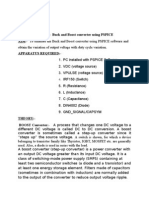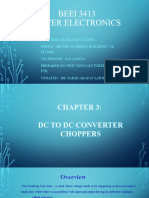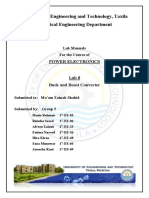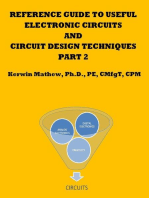Exp 1 simulation of buck and boost
Uploaded by
archanaExp 1 simulation of buck and boost
Uploaded by
archanaExperiment No.
2 a)
Design and Simulation of Buck Converter
AIM:
Design the values of filter inductance L and filter capacitance C of a buck converter with
input voltage Vs = 48V, average output voltage Vo = 12V and load resistance R = 10Ω.
Switching frequency is 40kHz. The peak to peak ripple inductance current is to be limited
to 0.045A and peak to peak ripple capacitor voltage is to be limited to 0.12V. Also,
simulate the circuit.
PRINCIPLE :
DC-DC CONVERTERS :
DC-DC power converters are widely used in regulated switch-mode dc power supplies and dc
motor drive applications. The input to the DC-DC converter is an unregulated dc voltage Vs. The
converter produces a regulated output voltage Vo, having a magnitude that differs from Vs.
Different DC-DC converters are i) Step-down (buck) converter, ii) Step-up (boost) converter iii)
Step-down/step-up (buck-boost) converter iv) Cuk Converter and v) SEPIC (single-ended primary
inductance) converter.
BUCK CONVERTER : A buck converter produces a lower average output voltage Vo than the
dc input voltage Vs.
During the interval when the switch is ON, the diode becomes reverse biased and the input
provides energy to the load as well as to the inductor. During the interval when the switch is off,
the inductor current flows through the diode, transferring some of its stored energy to the load.
The filter capacitor at the output is assumed to be very large so that vo(t) = Vo.
DESIGN:
Duty ratio, D = Vo = 12 = 0.25
Vs 48
Vs D (1 − D ) 48 × 0.25 × (1 − 0.25)
L= = = 5mH
f × ΔI L 40 × 103 × 0.045
Vs D (1 − D ) 48 × 0.25 × (1 − 0.25)
C= = = 1.17 μ F
8 f 2 L × ΔVc 8 × (40 × 103 ) 2 × 5 × 10−3 × 0.12
Simulink Blocks Used:-
R,L,C – series RLC branch
S7 Power Electronics Lab Manual as on 01-07-2016, EED, GEC Thrissur Page 6 of 27
PG – Pulse Generator (Amplitude 1, period 2.5x10-5, pulse width 25%)
MOSFET, DIODE (from Simpower systems – Power Electronics)
48V - Dc voltage source
Voltage measurement, current measurement
RESULT:
Buck converter was designed and simulated.
S7 Power Electronics Lab Manual as on 01-07-2016, EED, GEC Thrissur Page 7 of 27
Experiment No. 2 b)
Design and Simulation of Boost Converter
AIM:
Design the values of filter inductance L and filter capacitance C of a boost converter with
input voltage Vs = 5V, average output voltage Vo = 15V and load resistance R = 30Ω.
Switching frequency is 25kHz. The peak to peak ripple inductance current is to be limited
to 0.89A and peak to peak ripple capacitor voltage is to be limited to 0.06V. Also, simulate
the circuit.
PRINCIPLE:
BOOST CONVERTER : In Boost converters, the output voltage is always greater than the
input voltage.
When the switch is ON, the diode is reverse biased, thus isolating the output voltage. The input
supplies energy to the inductor. When the switch is OFF, the output stage receives energy from
the inductor as well as from the input.
DESIGN:
Vs 5
Duty ratio, D = 1 − = 1 − = 0.6667
Vo 15
Vo 15
Io = = = 0.5 A
R 30
Vs D 5 × 0.6667
L= = = 150 μ H
f × ΔI L 25 × 103 × 0.89
Io D 0.5 × 0.6667
C= = = 222 μ F
f × ΔVc 25 × 103 × 0.06
Simulink Blocks Used:-
R,L,C – series RLC branch
PG – Pulse Generator (Amplitude 1, period 4x10-5, pulse width 66.67%)
MOSFET, DIODE (from Simpower systems – Power Electronics)
S7 Power Electronics Lab Manual as on 01-07-2016, EED, GEC Thrissur Page 8 of 27
5V - Dc voltage source
Voltage measurement, current measurement
RESULT:
Boost converter was designed and simulated.
S7 Power Electronics Lab Manual as on 01-07-2016, EED, GEC Thrissur Page 9 of 27
Experiment No. 2 c)
Design and Simulation of Buck-Boost Converter
AIM:
Design the values of filter inductance L and filter capacitance C of a buck-boost converter
with input voltage Vs = 12V, average output voltage Vo = -4V and load resistance R =
3.2Ω. Switching frequency is 25kHz. The peak to peak ripple inductance current is to be
limited to 0.8A and peak to peak ripple capacitor voltage is to be limited to 0.06V. Also,
simulate the circuit.
PRINCIPLE:
BUCK-BOOST CONVERTER : In buck-boost converters, the output voltage is either higher
or lower than the input voltage; but the polarity of the output voltage is reversed with respect to
the input voltage.
When the switch is ON, the diode is reverse biased and input provides energy to the inductor.
When the switch is OFF, the energy stored in the inductor is transferred to the output. No energy
is supplied by the input during this interval.
DESIGN:
Duty ratio, D = Vo = 4 = 0.25
Vs + Vo 12 + 4
Vo 4
Io = = = 1.25 A
R 3.2
Vs D 12 × 0.25
L= = = 150 μ H
f × ΔI L 25 × 103 × 0.8
Io D 1.25 × 0.25
C= = = 208μ F
f × ΔVc 25 × 103 × 0.06
Simulink Blocks Used:-
R,L,C – series RLC branch
PG – Pulse Generator (Amplitude 1, period 4x10-5, pulse width 25%)
MOSFET, DIODE (from Simpower systems – Power Electronics)
S7 Power Electronics Lab Manual as on 01-07-2016, EED, GEC Thrissur Page 10 of 27
12V - Dc voltage source
Voltage measurement, current measurement
RESULT:
Buck-Boost converter was designed and simulated.
S7 Power Electronics Lab Manual as on 01-07-2016, EED, GEC Thrissur Page 11 of 27
You might also like
- Dr. Assad Abu-Jasser, ECE-iugaza: Electrical Machines (EELE 4350)67% (6)Dr. Assad Abu-Jasser, ECE-iugaza: Electrical Machines (EELE 4350)37 pages
- Main Objective:: Student Name: Ga Name: Matric NumberNo ratings yetMain Objective:: Student Name: Ga Name: Matric Number19 pages
- Experiment 2 - DC-DC Step-Up (Boost) Converter100% (2)Experiment 2 - DC-DC Step-Up (Boost) Converter6 pages
- Ex No:6 Modelling and Simulation of Buck and Boost Converter 10.11.2014No ratings yetEx No:6 Modelling and Simulation of Buck and Boost Converter 10.11.20146 pages
- V.Purna Sai Sandeep Reddy U17EC140: Esd Lab-1 (Linear Voltage Regulator)No ratings yetV.Purna Sai Sandeep Reddy U17EC140: Esd Lab-1 (Linear Voltage Regulator)27 pages
- Lab Experiment - Introduction To Switch Mode Power SupplyNo ratings yetLab Experiment - Introduction To Switch Mode Power Supply9 pages
- Power Electronic Lab: Experiment - 5 Buck - Boost Converter AimNo ratings yetPower Electronic Lab: Experiment - 5 Buck - Boost Converter Aim7 pages
- Reference Guide To Useful Electronic Circuits And Circuit Design Techniques - Part 1From EverandReference Guide To Useful Electronic Circuits And Circuit Design Techniques - Part 12.5/5 (3)
- A Implementation of Single-Switch Nonisolated Transformerless Buck-Boost DC-DC ConverterNo ratings yetA Implementation of Single-Switch Nonisolated Transformerless Buck-Boost DC-DC Converter6 pages
- Expt. 8 DC-DC Buck Boost Converter: Aim of The ExperimentNo ratings yetExpt. 8 DC-DC Buck Boost Converter: Aim of The Experiment3 pages
- exp2 Simulation of Buck-Boost convereterNo ratings yetexp2 Simulation of Buck-Boost convereter3 pages
- Tushar Taru - Logbook - Power Electronics - 2021No ratings yetTushar Taru - Logbook - Power Electronics - 202114 pages
- Lab05 Software buck and boost convertersNo ratings yetLab05 Software buck and boost converters8 pages
- Reference Guide To Useful Electronic Circuits And Circuit Design Techniques - Part 2From EverandReference Guide To Useful Electronic Circuits And Circuit Design Techniques - Part 2No ratings yet
- texio par20-4h par36-3h par20-4HL PAR36-3HL datasheetNo ratings yettexio par20-4h par36-3h par20-4HL PAR36-3HL datasheet4 pages
- How To Build SMPS Transformer Home Make 12V 10A SWNo ratings yetHow To Build SMPS Transformer Home Make 12V 10A SW11 pages
- An Overview of the AC-DC and DC-DC Converters for LED Lighting ApplicationsNo ratings yetAn Overview of the AC-DC and DC-DC Converters for LED Lighting Applications18 pages
- Buku Training Digsilent - HVDC - Exercises - eNo ratings yetBuku Training Digsilent - HVDC - Exercises - e9 pages
- Government Polytechnic, Murtizapur Year 2021-2022: Maharashtra State Board of Technical Education (Msbte)No ratings yetGovernment Polytechnic, Murtizapur Year 2021-2022: Maharashtra State Board of Technical Education (Msbte)5 pages
- KZJ3_SC14_220KV TRAFO-1_REV-Z_15.05.2024No ratings yetKZJ3_SC14_220KV TRAFO-1_REV-Z_15.05.202483 pages
- Dr. Assad Abu-Jasser, ECE-iugaza: Electrical Machines (EELE 4350)Dr. Assad Abu-Jasser, ECE-iugaza: Electrical Machines (EELE 4350)
- Main Objective:: Student Name: Ga Name: Matric NumberMain Objective:: Student Name: Ga Name: Matric Number
- Ex No:6 Modelling and Simulation of Buck and Boost Converter 10.11.2014Ex No:6 Modelling and Simulation of Buck and Boost Converter 10.11.2014
- V.Purna Sai Sandeep Reddy U17EC140: Esd Lab-1 (Linear Voltage Regulator)V.Purna Sai Sandeep Reddy U17EC140: Esd Lab-1 (Linear Voltage Regulator)
- Lab Experiment - Introduction To Switch Mode Power SupplyLab Experiment - Introduction To Switch Mode Power Supply
- Power Electronic Lab: Experiment - 5 Buck - Boost Converter AimPower Electronic Lab: Experiment - 5 Buck - Boost Converter Aim
- Reference Guide To Useful Electronic Circuits And Circuit Design Techniques - Part 1From EverandReference Guide To Useful Electronic Circuits And Circuit Design Techniques - Part 1
- A Implementation of Single-Switch Nonisolated Transformerless Buck-Boost DC-DC ConverterA Implementation of Single-Switch Nonisolated Transformerless Buck-Boost DC-DC Converter
- Expt. 8 DC-DC Buck Boost Converter: Aim of The ExperimentExpt. 8 DC-DC Buck Boost Converter: Aim of The Experiment
- Reference Guide To Useful Electronic Circuits And Circuit Design Techniques - Part 2From EverandReference Guide To Useful Electronic Circuits And Circuit Design Techniques - Part 2
- texio par20-4h par36-3h par20-4HL PAR36-3HL datasheettexio par20-4h par36-3h par20-4HL PAR36-3HL datasheet
- How To Build SMPS Transformer Home Make 12V 10A SWHow To Build SMPS Transformer Home Make 12V 10A SW
- An Overview of the AC-DC and DC-DC Converters for LED Lighting ApplicationsAn Overview of the AC-DC and DC-DC Converters for LED Lighting Applications
- Government Polytechnic, Murtizapur Year 2021-2022: Maharashtra State Board of Technical Education (Msbte)Government Polytechnic, Murtizapur Year 2021-2022: Maharashtra State Board of Technical Education (Msbte)

























































































